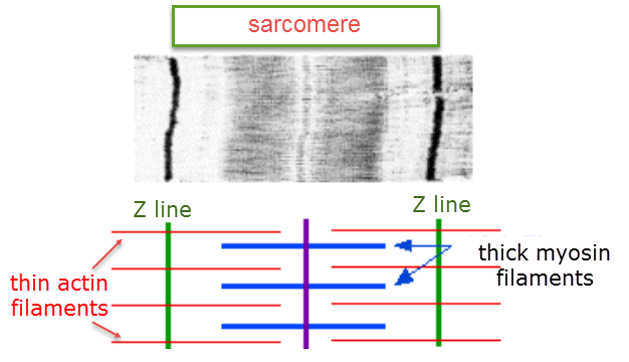Muscle structure & function.
 Students use a short powerpoint introduction to identify key points of muscle structure and the interaction between myosin and actin filaments in sarcomeres before answering some questions on a worksheet. In a second activity they discover the molecular details required for IB Biology and a final whole class activity helps students to memorise the details.
Students use a short powerpoint introduction to identify key points of muscle structure and the interaction between myosin and actin filaments in sarcomeres before answering some questions on a worksheet. In a second activity they discover the molecular details required for IB Biology and a final whole class activity helps students to memorise the details.
Lesson Description
 Guiding Questions
Guiding Questions
Skeletal muscle is made from long fibres rather than small square cells. What is the advantage of long fibres in muscle contraction?
Why is skeletal muscle considered an exception to cell theory?
At the protein level - what happens when a muscle contracts.
Activity 1 - Muscle structure
Watch the following ![]() slides about the detailed structure of skeletal muscle. Then answer the questions on the worksheet below.
slides about the detailed structure of skeletal muscle. Then answer the questions on the worksheet below.
Answer the questions on the ![]() student worksheet on muscle structure
student worksheet on muscle structure
Activity 2 - Muscle contraction
Study the ten steps on this ![]() presentation of the detail of muscle contraction.
presentation of the detail of muscle contraction.
or the Simpler alternative in just six steps ![]() muscle contraction in six steps
muscle contraction in six steps
Complete the ![]() student worksheet for notes about muscle contractions which follows to prepare for activity 3
student worksheet for notes about muscle contractions which follows to prepare for activity 3
Activity 3 - Explaining muscle contraction - class activity.
This is a class activity to help everyone to learn the details of the stages and to give students an opportunity to ask about things they don't understand in a discrete way.
Instructions
Using the slides from activity 2, allocate one step of the explanation to each member of the class.
(Pairs are acceptable if >10 students)
Ask the students to prepare their individual explanation of this one step.
Play the slides as students narrate the process. (For a video of the slides click the eye icon)
At the end of the explanation, students rotate one step forwards - 1a becomes 1b etc. 5b becomes 1a
Students should take a minute or two to teach each other the new steps.
Repeat the explanation 10 times, until everyone has explained each step.
For a bit of added pressure try to time each explanation and see if the explanation becomes faster.
Teachers notes
These activities will take about 1 hour.
Activity 1 is a simple introduction to the structure of muscle fibres and an overview of the location of sarcomeres.
Model answers can be found here:
Activity 2 looks at the details of the sliding filament theory of muscle contraction. Students first read an explanation, make their own notes of the details on the worksheet.
Activity 3 is a great way to help students to learn the details of the process in a collaborative way, allowing students to work with a wider range of people from the class, in a supportive way. The best way to succeed at the activity is by cooperating and helping others.
Note: in the IB guide there is specific mention of drawing diagrams to explain the structure of a sarcomere, recognition of the state of contraction from electron micrographs and measurement of the length of sarcomeres.

 IB Docs (2) Team
IB Docs (2) Team
